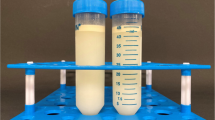Abstract
Chylothorax is a well-described complication after cardiothoracic surgery in children. Medical nutritional therapy for chylothorax includes medium-chain triglyceride (MCT) formulas and reduction in enteral long-chain triglyceride intake to reduce chyle production. Human milk is usually eliminated from the diet of infants with chylothorax because of its high long-chain triglyceride content. However, given the immunologic properties of human milk, young infants with chylothorax may benefit from using human milk over human milk substitutes. We performed a retrospective cohort study to describe the feasibility and efficacy of defatted human milk (DHM) for the treatment for chylothorax in infants after cardiac surgery and to compare growth outcomes between infants treated with DHM (n = 14) versus MCT formula (n = 21). There were no differences in mortality or length of hospital stay between the DHM and MCT formula treatment groups. The DHM treatment group had a significantly higher weight-for-age z-score at hospital discharge compared to the MCT formula group with median z-scores of −1 (−2 to 0.5) and −1.5 (−2 to 0), respectively (p = 0.02). In infants with chylothorax after cardiac surgery, DHM is a safe and feasible medical nutritional treatment and may have potential benefits for improved nutrition and growth.

Similar content being viewed by others
References
Biewer ES, Zurn C, Arnold R, Glockler M, Schulte-Monting J, Schlensak C, Dittrich S (2010) Chylothorax after surgery on congenital heart disease in newborns and infants-risk factors and efficacy of MCT-diet. J Cardiothorac Surg 5:127
Chan EH, Russell JL, Williams WG, Van Arsdell GS, Coles JG, McCrindle BW (2005) Postoperative chylothorax after cardiothoracic surgery in children. Ann Thorac Surg 80:1864–1870
Mery CM, Moffett BS, Khan MS, Zhang W, Guzman-Pruneda FA, Fraser CD Jr, Cabrera AG (2014) Incidence and treatment of chylothorax after cardiac surgery in children: analysis of a large multi-institution database. J Thorac Cardiovasc Surg 147:678–686
Zuluaga MT (2012) Chylothorax after surgery for congenital heart disease. Curr Opin Pediatr 24:291–294
Brown KL, Ridout DA, Goldman AP, Hoskote A, Penny DJ (2003) Risk factors for long intensive care unit stay after cardiopulmonary bypass in children. Crit Care Med 31:28–33
Beghetti M, La Scala G, Belli D, Bugmann P, Kalangos A, Le Coultre C (2000) Etiology and management of pediatric chylothorax. J Pediatr 136:653–658
Allen EM, van Heeckeren DW, Spector ML, Blumer JL (1991) Management of nutritional and infectious complications of postoperative chylothorax in children. J Pediatr Surg 26:1169–1174
Caverly L, Rausch CM, da Cruz E, Kaufman J (2010) Octreotide treatment of chylothorax in pediatric patients following cardiothoracic surgery. Congenit Heart Dis 5:573–578
Itkin M, Kucharczuk JC, Kwak A, Trerotola SO, Kaiser LR (2010) Nonoperative thoracic duct embolization for traumatic thoracic duct leak: experience in 109 patients. J Thorac Cardiovasc Surg 139:584–590
Nath DS, Savla J, Khemani RG, Nussbaum DP, Greene CL, Wells WJ (2009) Thoracic duct ligation for persistent chylothorax after pediatric cardiothoracic surgery. Ann Thorac Surg 88:246–251
Yeh J, Brown ER, Kellogg KA, Donohue JE, Yu S, Gaies MG, Fifer CG, Hirsch JC, Aiyagari R (2013) Utility of a clinical practice guideline in treatment of chylothorax in the postoperative congenital heart patient. Ann Thorac Surg 96:930–936
Innis SM (1992) Human milk and formula fatty acids. J Pediatr 120:S56–S61
Dvorak B (2010) Milk epidermal growth factor and gut protection. J Pediatr 156:S31–S35
Goldman AS (2007) The immune system in human milk and the developing infant. Breastfeed Med 2:195–204
Raiten DJ, Kalhan SC, Hay WW Jr (2007) Maternal nutrition and optimal infant feeding practices: executive summary. Am J Clin Nutr 85:577S–583S
Taylor SN, Basile LA, Ebeling M, Wagner CL (2009) Intestinal permeability in preterm infants by feeding type: mother’s milk versus formula. Breastfeed Med 4:11–15
Walker WA (2004) The dynamic effects of breastfeeding on intestinal development and host defense. Adv Exp Med Biol 554:155–170
Geneva: World health organization (2009) WHO child growth standards and the identification of severe acute malnutrition in infants and children: a joint statement by the World Health Organization and the United Nations children’s fund
Wang CD, Chu PS, Mellen BG, Shenai JP (1999) Creamatocrit and the nutrient composition of human milk. J Perinatol 19:343–346
Kocel SL, Russell J, O’Connor DL (2015) Fat-modified breast milk resolves chylous pleural effusion in infants with postsurgical chylothorax but is associated with slow growth. JPEN J Parenter Enteral Nutr. doi:10.1177/0148607114566464
del Castillo SL, McCulley ME, Khemani RG, Jeffries HE, Thomas DW, Peregrine J, Wells WJ, Starnes VA, Moromisato DY (2010) Reducing the incidence of necrotizing enterocolitis in neonates with hypoplastic left heart syndrome with the introduction of an enteral feed protocol. Pediatr Crit Care Med 11:373–377
Anderson JB, Marino BS, Irving SY, Garcia-Espana JF, Ravishankar C, Stallings VA, Medoff-Cooper B (2011) Poor post-operative growth in infants with two-ventricle physiology. Cardiol Young 21:421–429
Burch PT, Gerstenberger E, Ravishankar C et al (2014) Longitudinal assessment of growth in hypoplastic left heart syndrome: results from the single ventricle reconstruction trial. J Am Heart Assoc 3:e000079
Ravishankar C, Zak V, Williams IA et al (2013) Association of impaired linear growth and worse neurodevelopmental outcome in infants with single ventricle physiology: a report from the pediatric heart network infant single ventricle trial. J Pediatr 162:250–256
Acknowledgments
The authors thank the Emerson Rose Heart Foundation for their support.
Author information
Authors and Affiliations
Corresponding author
Ethics declarations
Conflict of Interest
The authors declare that they have no conflict of interest.
Ethical Approval
All procedures performed in studies involving human participation were in accordance with the ethical standards of the Institutional and/or National Research Committee and with the 1964 Declaration of Helsinki and its later amendments or comparable ethical standards. For this type of study, formal consent is not required.
Rights and permissions
About this article
Cite this article
Fogg, K.L., DellaValle, D.M., Buckley, J.R. et al. Feasibility and Efficacy of Defatted Human Milk in the Treatment for Chylothorax After Cardiac Surgery in Infants. Pediatr Cardiol 37, 1072–1077 (2016). https://doi.org/10.1007/s00246-016-1393-8
Received:
Accepted:
Published:
Issue Date:
DOI: https://doi.org/10.1007/s00246-016-1393-8




